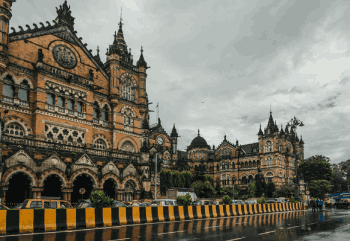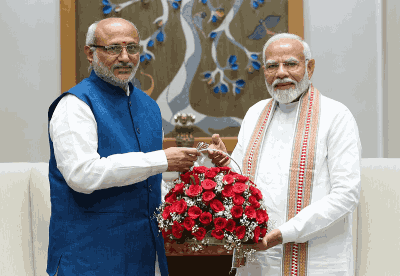Election Timeline
The current assembly term expires on November 22, 2025, making the election mandatory before this date. The Election Commission is expected to announce the schedule in September 2025, with polls likely in October-November 2025.
Current Political Landscape
Ruling Alliance Structure
National Democratic Alliance (NDA) currently governs Bihar under Chief Minister Nitish Kumar, following his dramatic return to the BJP-led coalition in January 2024. The alliance comprises:
- Janata Dal (United) – JD(U): Led by Nitish Kumar, targeting 102-103 seats
- Bharatiya Janata Party – BJP: Led by Dilip Jaiswal, contesting 101-102 seats
- Lok Janshakti Party (Ram Vilas) – LJP(RV): Led by Chirag Paswan, expecting 25-28 seats
- Hindustani Awam Morcha (Secular) – HAM(S): Led by Jitan Manjhi
- Rashtriya Lok Morcha – RLM: Led by Upendra Kushwaha
Opposition Alliance
Mahagathbandhan (Grand Alliance) represents the primary opposition, featuring:
- Rashtriya Janata Dal – RJD: Led by Tejashwi Yadav as CM candidate
- Indian National Congress: Led by Rahul Gandhi, with reluctance to endorse Tejashwi
- Left Front: CPI(ML)L, CPI, CPI(M)
- Vikassheel Insaan Party – VIP: Led by Mukesh Sahani
New Political Force
Jan Suraaj Party: Founded by Prashant Kishor on October 2, 2024, representing a third alternative challenging traditional politics.
Demographic and Social Analysis
Caste Composition Impact
Bihar’s 2023 caste survey revealed crucial demographic realities shaping electoral strategies:
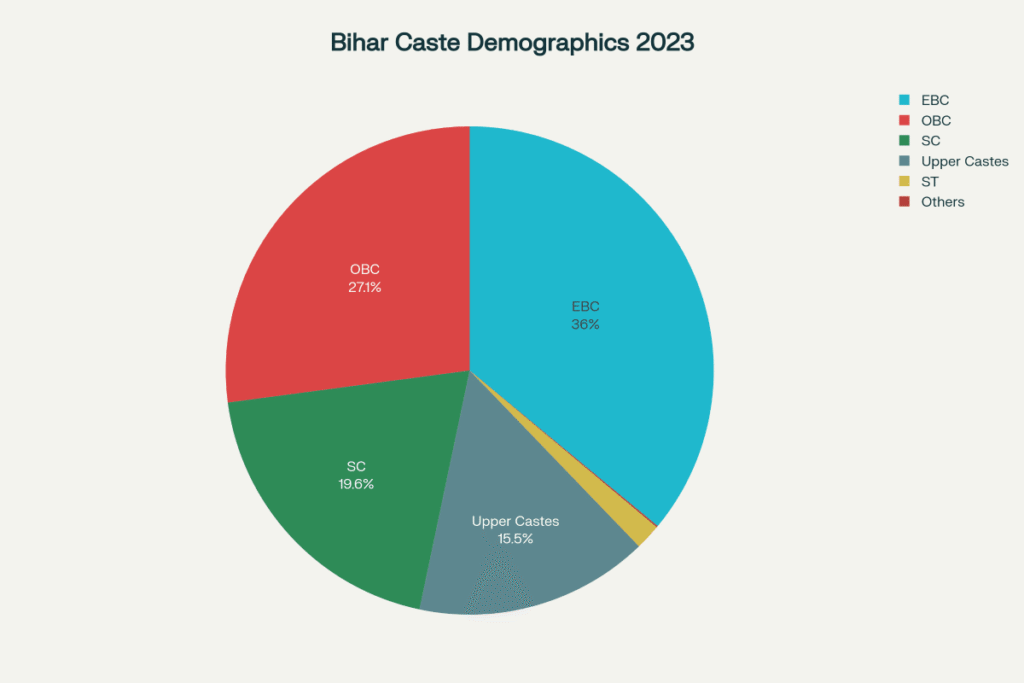
Bihar caste demographics showing EBC and OBC dominance at 63.1% combined
Key Findings:
- Extremely Backward Classes (EBC): 36.0% – JD(U)’s core support base
- Other Backward Classes (OBC): 27.1% – RJD’s traditional stronghold
- Scheduled Castes: 19.6% – Contested by multiple parties
- Upper Castes: 15.5% – BJP’s primary base
- Scheduled Tribes: 1.7% – Limited electoral impact
Electoral Mathematics
The combined EBC+OBC population of 63.1% represents the decisive electoral bloc, explaining why caste census and reservation policies dominate campaign narratives.
Key Election Issues and Voter Priorities
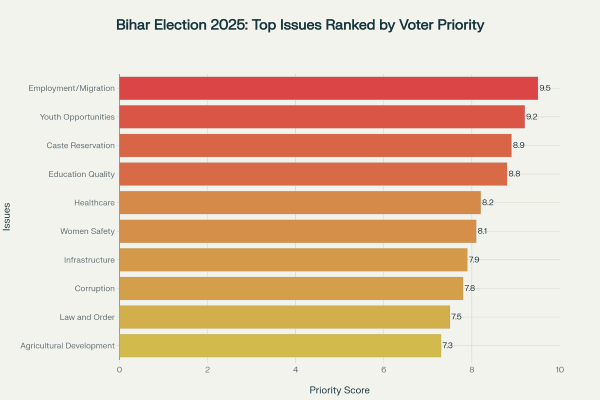
Key voter priorities for Bihar 2025 election with employment and youth issues topping concerns
Primary Concerns
Employment and Migration Crisis: Bihar’s chronic unemployment forces millions to migrate to other states for work. This represents the top voter priority at 9.5/10 importance.
Youth Opportunities: With over 60% population under 35, youth-focused policies including education, skill development, and entrepreneurship rank as the second-highest priority.
Caste Reservation Debate: Following the caste survey, reservation policies remain contentious, especially after the Patna High Court struck down Bihar’s 65% reservation.
Major Campaign Strategies and Manifestos
NDA Campaign Approach
Development and Stability Narrative:
- Nitish Kumar’s Experience: Emphasizing his 20+ years of governance
- “Double Engine” Government: Leveraging BJP’s central power and state alliance
- Infrastructure Projects: ₹1,000+ crore announcements during recent rallies
- Women Empowerment: Continuing Mahila schemes and safety initiatives
Mahagathbandhan Strategy
Change and Social Justice Platform:
- Tejashwi Yadav as CM Face: RJD’s clear positioning despite Congress reluctance
- Employment Guarantee: Promise of massive job creation
- Caste Justice: Restoration of 65% reservation and social equity
- Anti-Incumbency: 20-year anti-incumbency against Nitish Kumar
Jan Suraaj’s Disruption Model
Citizen-Led Governance:
- Education Investment: ₹5 lakh crore over 10 years funded by liquor excise revenue
- Economic Reforms: Lifting liquor prohibition for development funding
- Decentralization: Right to recall and citizen participation
- Youth Focus: 4% interest loans to women entrepreneurs
Seat Projections and Electoral Mathematics
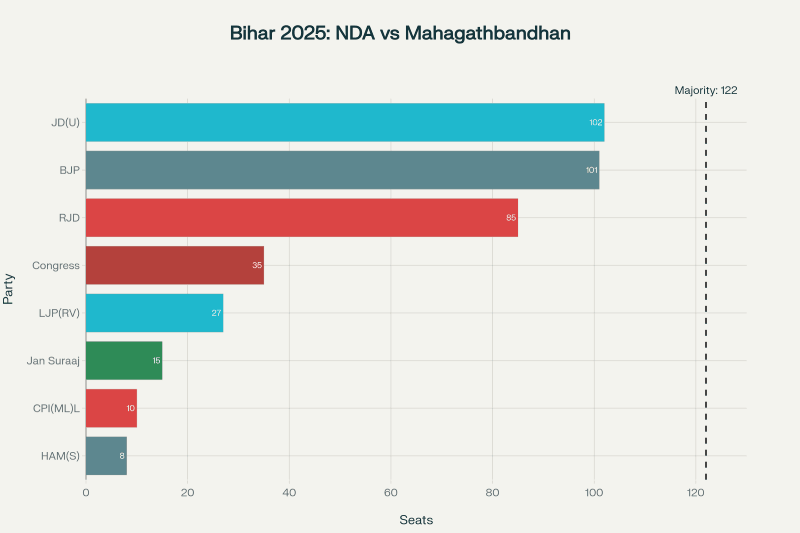
Projected seat distribution showing NDA’s narrow advantage over Mahagathbandhan in 243-seat assembly
Projected Distribution
NDA Alliance: ~241 seats (Potential majority)
- JD(U): 102 seats
- BJP: 101 seats
- LJP(RV): 27 seats
- Others: 11 seats
Mahagathbandhan: ~143 seats
- RJD: 85 seats
- Congress: 35 seats
- Left parties: 15 seats
- Others: 8 seats
Independents and Others: ~15 seats
- Jan Suraaj Party: 10-20 seats (potential kingmaker)
Critical Challenges and Controversies
Voter Roll Revision Crisis
The Special Intensive Revision (SIR) of electoral rolls has created major controversy:
Opposition Allegations:
- 4.5 crore voters potentially disenfranchised
- Systematic targeting of Muslim and Dalit voters
- Threat of election boycott by Mahagathbandhan
Election Commission Defense:
- Routine exercise after 22 years
- Foreign infiltration concerns addressed
- All eligible voters will be included
Leadership Uncertainties
Nitish Kumar’s Future: At 74 years old, speculation about his final electoral battle and potential succession planning.
BJP’s CM Strategy: Uncertainty about Nitish’s continuation as CM face, with potential Maharashtra-style leadership change.
Regional and Constituency Analysis
Geographic Strongholds
NDA Dominance:
- Northern Bihar: EBC-dominated constituencies
- Urban Centers: Middle-class and upper-caste areas
- Eastern Border: Development-focused regions
Mahagathbandhan Strength:
- Central Bihar: Yadav-Muslim concentrated areas
- Southern Districts: Backward caste populations
- Rural Constituencies: Agricultural communities
Swing Constituencies
Competitive Seats: Approximately 80-90 constituencies with victory margins under 10,000 votes in 2020, making them crucial battlegrounds.
Economic and Development Factors
State Financial Position
Revenue Challenges:
- Bihar’s poor credit-deposit ratio of 35% vs national average 75%
- Migration remittances as major income source
- Limited industrial base affecting employment generation
Infrastructure Progress:
- Road connectivity improvements under NDA rule
- Education infrastructure expansion
- Healthcare facility upgrades
Electoral Predictions and Scenarios
Most Likely Outcome
NDA Narrow Victory: 125-135 seats based on:
- Incumbency advantage with development narrative
- Nitish Kumar’s continued appeal among EBCs
- BJP’s organizational strength
- Opposition fragmentation
Alternative Scenarios
Mahagathbandhan Revival: 120-130 seats if:
- Anti-incumbency intensifies significantly
- Successful caste mobilization by RJD
- Congress strengthens grassroots presence
- Youth unemployment becomes decisive issue
Hung Assembly: No clear majority leading to:
- Coalition negotiations
- Jan Suraaj as kingmaker
- Post-poll realignments
Key Players to Watch
Established Leaders
Nitish Kumar (JD-U): The central figure whose political survival depends on this election.
Tejashwi Yadav (RJD): 35-year-old leader positioning himself as the change candidate.
Chirag Paswan (LJP-RV): Rising Dalit leader with significant influence in 25+ constituencies.
Emerging Forces
Prashant Kishor (Jan Suraaj): The political strategist turned politician with 1 crore claimed membership.
Manoj Bharti (Jan Suraaj President): Former diplomat leading organizational structure.
Election Timeline and Process
Key Dates
- September 2025: Election Commission schedule announcement
- October-November 2025: Polling phases (likely 2-3 phases)
- November 22, 2025: Constitutional deadline for new assembly
Logistical Considerations
Voter Registration: 7.9 crore registered voters across 243 constituencies.
Security Arrangements: Multi-phase polling due to law and order concerns in certain regions.
Strategic Recommendations
For Political Parties
NDA Strategy:
- Emphasize governance record and development achievements
- Address youth unemployment with concrete job creation plans
- Maintain caste coalition balance between upper castes and EBCs
Mahagathbandhan Approach:
- Resolve CM candidate issue to avoid voter confusion
- Strengthen ground organization in all 243 constituencies
- Focus on bread-and-butter issues beyond caste politics
Jan Suraaj Positioning:
- Target urban educated voters disillusioned with traditional politics
- Build credible candidate network across constituencies
- Leverage Prashant Kishor’s strategic expertise effectively
Conclusion and Outlook
The Bihar Assembly Election 2025 represents a watershed moment in the state’s political evolution. With Nitish Kumar potentially fighting his last election, Tejashwi Yadav seeking to establish RJD supremacy, and Prashant Kishor attempting political disruption, the stakes couldn’t be higher.
Key Determinants:
- Voter roll revision controversy resolution
- Youth unemployment response effectiveness
- Caste mobilization success by different parties
- Anti-incumbency vs stability narrative victory
The election outcome will not only determine Bihar’s governance for the next five years but also influence national politics, given the state’s 40 Lok Sabha seats and strategic importance in federal coalition building.
Final Prediction: NDA is likely to retain power with a narrow majority, but the emergence of Jan Suraaj as a significant force and potential post-poll realignments make this election highly unpredictable and crucial for Bihar’s political future.





